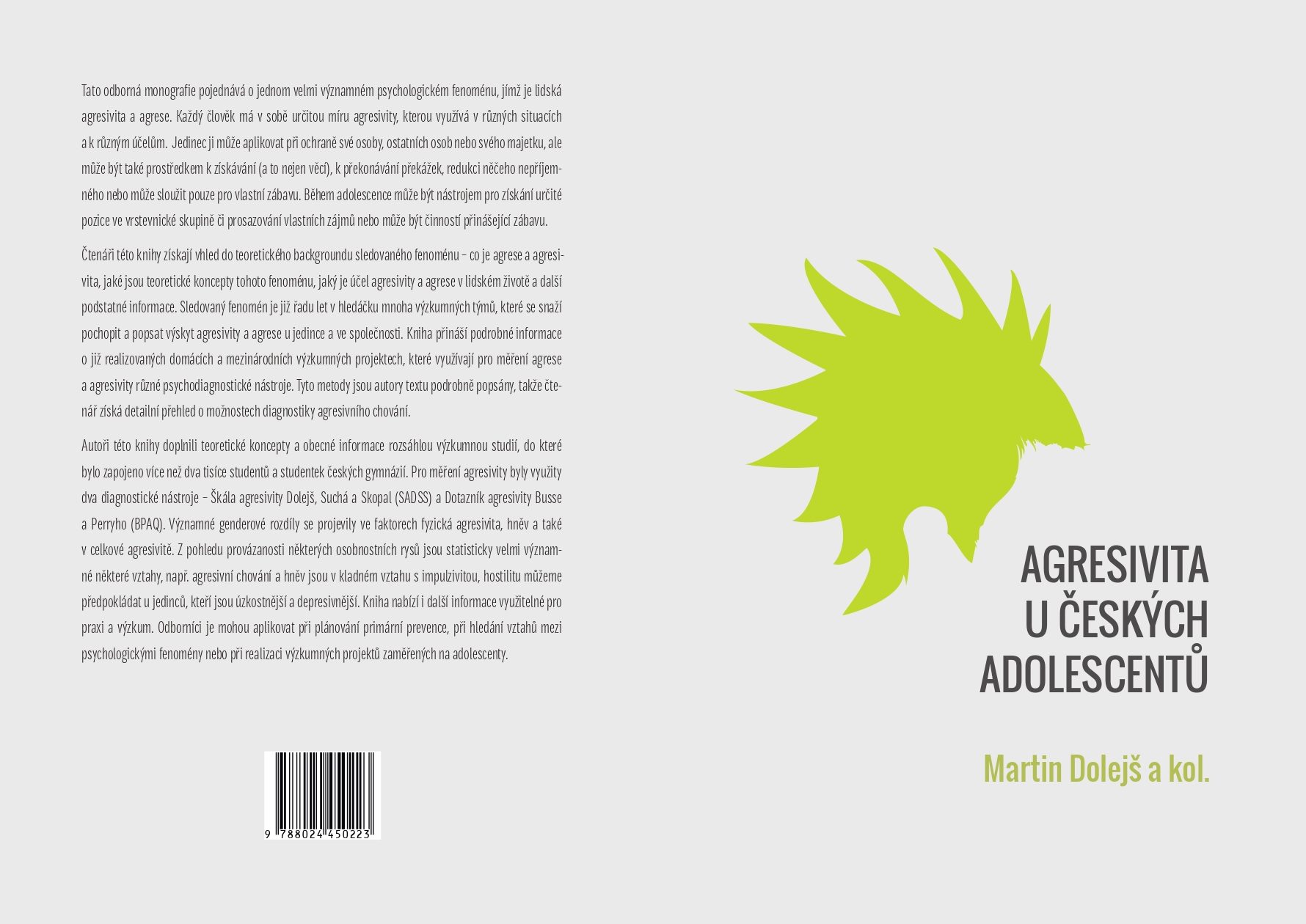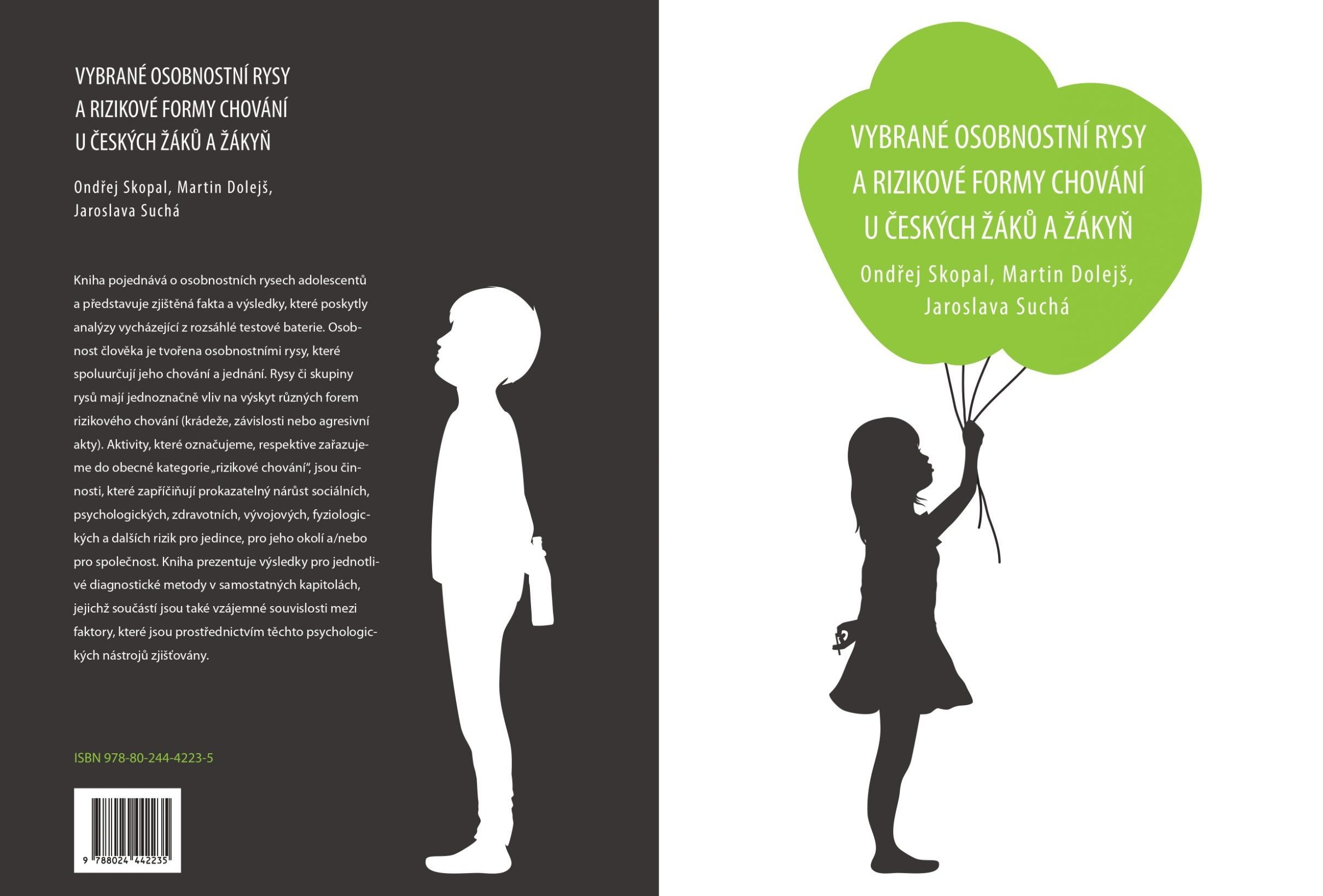
Category: agresivita


Bc.- Vztah agresivity s impulzivitou a s rizikovým chováním u studentů různých typů středních škol v ČR
Author: Štěpán Komrska
Supervisor: Jaroslava Suchá
Práce je zaměřena na zhodnocení rozdílů mezi studenty jednotlivých typů středních škol (střední škola s maturitou, střední škola bez maturity, gymnázium). Studenti jsou v rámci výzkumu srovnáváni ve třech proměnných (agresivita, impulzivita, rizikové chování). Pro zhodnocení agresivity byl použit Dotazník agresivity Busse a Perryho, pro impulzivitu Škála impulzivity Dolejš, Skopal a pro rizikové chování Výskyt rizikového chování u adolescentů. Zaměřili jsme se na adolescenty ve věku 15–19 let a náš výběrový soubor tvořilo 2 522 respondentů. Hlavním zjištěním práce je naměřený výrazný rozdíl mezi studenty jednotlivých středních škol v agresivitě na hladině významnosti α = 0,05. Dále jsme pozorovali významný rozdíl mezi studenty středních škol bez maturity a gymnázií v rizikovém chování. Z hlediska pohlaví se nám podařilo potvrdit předpoklad statisticky vyššího průměrného skórování chlapců, oproti dívkám pouze v agresivitě. V rámci dílčích faktorů agresivity byly naměřeny významné rozdíly mezi všemi typy středních škol u fyzické agresivity. Zjištění mohou přispět k efektivitě práce se studenty různých typů středních škol a k předpovídání jejich chování v období adolescence ve školním prostředí.
The relationship between aggressivness, impulsivity and risk behaviour of students from different types of secondary schools in the Czech Republic
The thesis is focused on evaluation of different types of secondary schools (secondary school with school leaving exam, secondary school without school leaving exam, grammar school). Within the research, the students are compared in three variables (aggression, impulsivity, risk behaviour). To assess aggression, Buss-Perry Aggression Questionnaire was used, for assessing impulsivity Dolejš-Skopal Impulsivity Scale and The Scale of Risk Behavior in Adolescents for risk behaviour occurrence. We were focused on adolescents aged 15–19, and our sample comprised 2 522 respondents. The main finding of the thesis is a significant difference between students of particular secondary schools in aggression at the significance value α = 0,05. Furthermore, we observed a significant difference in risky behaviour between students of secondary schools without school leaving exam and grammar school students. From the gender point of view, we managed to confirm the assumption of statistically higher average score of boys compared to girls only in aggression. Significant differences between all types of secondary schools in physical aggression were measured within the subfactors of aggression. These findings can contribute to the effectiveness of the work with students of different secondary school types and to predicting their adolescence behaviour in the school environment.

Mgr.- Agresivita, depresivita a hraní digitálních her u studentů přecházejících ze základní na střední školu v období pandemie COVID-19
Author: Štěpán Komrska
Supervisor: Martin Dolejš
Práce je zaměřena na tři proměnné (agresivita, depresivita, hraní digitálních her) v kontextu přechodu ze základní na střední školu (gymnázium, střední škola s maturitou) během pandemie COVID-19. Pro zachycení rozdílů byla použita Škála agresivity Dolejš, Suchá a Skopal, Škála depresivity Dolejš, Skopal a Suchá a Dotazník hraní digitálních her. Kvantitativní longitudinální výzkumné šetření bylo realizováno v průběhu jednoho roku a skládalo se ze tří sběrů dat, které mezi sebou měly časový rozestup 6 měsíců. Výběrový soubor v prvním sběru dat tvořilo 296 respondentů ve věku 14–16 let. Na hladině statistické významnosti α = 0,05 se u agresivity podařilo prokázat statisticky významný rozdíl díky poklesu hostility mezi prvním a třetím měřením, mezi druhým a třetím měřením i ve snížení skóru oproti normovému souboru. Hněvivost klesla ve srovnání před a po druhé vlně pandemie. U hněvu byl dále oproti normovému souboru naměřen výrazný nárůst po první vlně pandemie. V depresivitě se ukázal statisticky významný nárůst po první vlně pandemie ve srovnání s normou. Důležité bylo potvrzení vyššího skóre chlapců v hraní digitálních her oproti dívkám (p < 0,001). Výsledky poskytují základ pro zkoumání vlivu pandemie a přechodu ze základní na střední školu.
Aggression, depression and playing digital games of students transitioning from primary to secondary school during the COVID-19 pandemic
The thesis is focused on three variables (aggression, depression, playing digital games) in the context of the transition from primary to secondary school (grammar school, secondary school with a school leaving exam) during the COVID-19 pandemic. The Scale of aggression Dolejš, Skopal, Suchá (SADSS), The Scale of depresivity Dolejš, Skopal, Suchá (SDDSS) and Questionnaire of Digital Game Playing (QDGP) were used to capture the differences. The quantitative longitudinal research survey was conducted over the course of one year and consisted of three data collections spaced 6 months apart. The sample in the first data collection comprised of 296 respondents aged 14–16 years. At the level of statistical significance α = 0.05 for aggression, a statistically significant decline in hostility was confirmed between the first and third measurements, between the second and third measurements, when compared to the norm. In accordance to the results, anger declined before and after the second wave of the pandemic. Anger raised significantly after the first wave of the pandemic. In depression, the statistically significant effect after the first wave of the pandemic increased when compared to the norm. It was important to confirm the higher score of boys in playing digital games compared to girls (p <0.001). The results provide a basis for examining the impact of the pandemic and the transition from primary to secondary

Mgr.- Souvislost agresivity a vybraných osobnostních charakteristik u studentů gymnázií ČR
Author: Jaroslava Suchá
Supervisor: Martin Dolejš
Práce se zaměřuje na oblast agresivity a její souvislost s vybranými osobnostními charakteristikami (sebehodnocení, impulzivita, depresivita). Mezi další cíle spadá posouzení míry agresivity z hlediska věku a genderu. Pro zhodnocení vymezených proměnných jsme použili Rosenbergovu škálu sebehodnocení, Škálu impulzivity Dolejš, Skopal, Škálu depresivity Dolejš, Skopal, Suchá a Dotazník agresivity Busse a Perryho. Základním souborem byli čeští studenti gymnázií ve věku 15–19 let. Výběrový soubor zahrnoval 2387 respondentů ze všech krajů ČR, jednalo se o 2,75 % sledované populace. Mezi hlavní výsledky, které práce přinesla, patří nalezené statisticky významné vztahy (p<0,001) mezi agresivitou a impulzivitou (r = .56 ), agresivitou a depresivitou (r = .38) a agresivitou a sebehodnocením (r = -.20). Na základě objasněných souvislostí je tedy možné předpokládat, že jedinec vykazující vysokou impulzivitu, depresivitu a nízké sebehodnocení bude mít také vyšší tendenci k agresivním projevům. Shledaná zjištění mohou přinést bližší porozumění osobnosti dospívajícího a tím přispět k zefektivnění práce s jednici nacházejícími se v nesnadné, ale zároveň významné etapě života.
The relationship between aggressiveness and some personality characteristics of comprehensive school students in the Czech
The thesis is focused on the field of aggressiveness and its relation with selected personality characteristics (self-esteem, impulsivity, depressivity). Further aims of the thesis are evaluation of aggressiveness level considering age and gender. To evaluate selected variables Rosenberg self-esteem scale was used as well as Impulsiveness scale Dolejš, Skopal, Depressiveness scale Dolejš, Skopal, Suchá and Buss Perry Aggression Questionnaire. Basic population consists of Czech high school students aged 15–19. The sample included 2387 participants from all Czech Republic regions, i.e. 2, 75% of the basic population. The most important results of the research are significant relations (p<0,001) between aggressiveness and impulsivity (r = .56), aggressiveness and depressivity (r = .38) and aggressiveness and self-esteem (r = -.20). Based on the relations this research helped to clarify we could assume that an individual exhibiting high level of impulsivity, depressivity and low self-esteem also tends to exhibit aggression more frequently. These conclusions could bring us to further understanding of adolescent personality and thus contribute to more effective approach to individuals finding themselves in difficult and at the same time significant stage of life.

Agresivita, depresivita, impulzivita a sebehodnocení u českých adolescentů
Suchá, J., & Dolejš, M. (2016). Agresivita, depresivita, impulzivita a sebehodnocení u českých adolescentů. Olomouc: Univerzita Palackého v Olomouci.
Agresivita u českých adolescentů
Dolejš, M., Suchá, J., Skopal, O., & Vavrysová, L. (2016). Agresivita u českých adolescentů. Olomouc: Univerzita Palackého v Olomouci.
Vybrané osobnostní rysy a rizikové formy chování u českých žáků a žákyň
Skopal, O., Dolejš, M., & Suchá, J. (2014). Vybrané osobnostní rysy a rizikové formy chování u českých žáků a žákyň. Olomouc: Univerzita Palackého v Olomouci.

